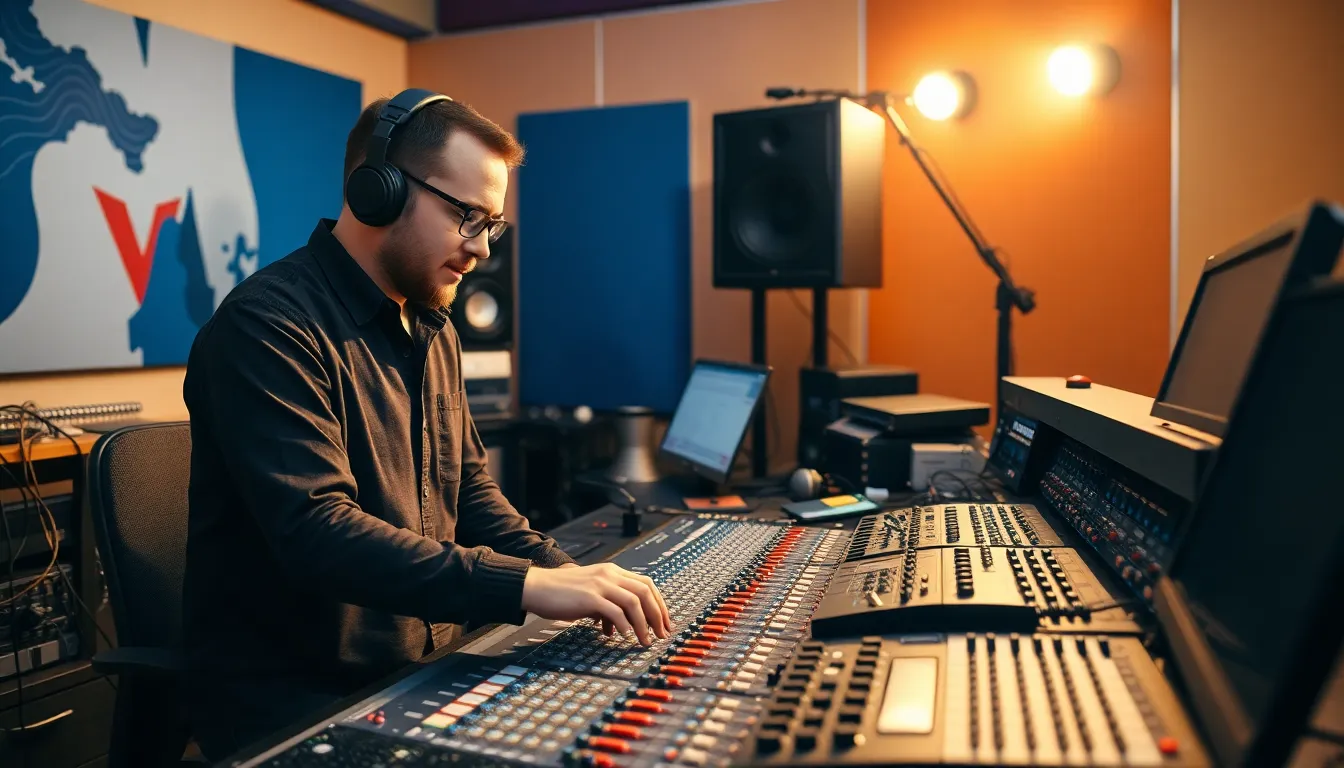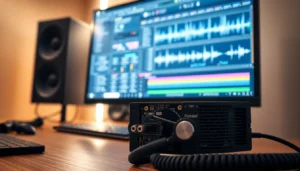In the world of audio production, a mixer board is like the Swiss Army knife of sound. It’s the unsung hero that transforms raw audio into a polished masterpiece. Whether you’re a budding musician or a seasoned sound engineer, mastering this essential tool can elevate your sound game from amateur to pro in no time.
Picture this: you’re at a party, and the DJ is spinning tracks that make everyone dance. Behind that infectious groove is a mixer board, working its magic. It balances levels, adds effects, and ensures every beat hits just right. Without it, that party could quickly turn into a cringe-worthy karaoke night. So, let’s dive into the world of mixer boards and discover how they can help create audio that not only sounds good but also gets people moving.
Table of Contents
ToggleOverview of Mixer Boards
Mixer boards play a crucial role in audio production. They serve as central hubs for sound management, allowing users to control various audio sources simultaneously. Each mixer board includes input channels, which accept signals from microphones, instruments, and other devices. High-quality boards feature multiple channels, ensuring flexibility in mixing.
Channels on a mixer board allow adjustment of levels and application of effects. For instance, each channel often includes volume faders, EQ controls, and auxiliary send options. Volume faders enable smooth transitions between sounds. EQ controls help shape the audio by boosting or cutting frequencies. Auxiliary sends route signals to effects processors or monitors, enhancing the overall sound.
The layout of a mixer board often includes a master section. This section controls the overall output and monitors the final mix. With matrix routing capabilities, users can send audio to different outputs based on specific needs. Many mixer boards come equipped with built-in effects processors, streamlining the process of adding reverb, delay, and other effects.
Users can choose between analog and digital mixer boards. Analog boards provide a tactile experience, appealing to traditionalists. Digital mixer boards offer advanced features, like automation and comprehensive control over sound manipulation. Each type has its advantages depending on the user’s needs and preferences.
Proficiency with mixer boards enhances audio production skills. Understanding their functionality allows for creative possibilities, whether creating music or managing live sound. The significance of mastering these tools cannot be overstated, as they directly impact the quality of the final audio product.
Types of Mixer Boards

Mixer boards come in various types, primarily categorized as analog or digital. Each type offers unique features and benefits suited to different audio production needs.
Analog Mixer Boards
Analog mixer boards deliver a hands-on experience for sound engineers. These boards feature physical knobs and faders, allowing users to adjust levels intuitively. Sound manipulation occurs through electrical signals, which some professionals prefer for their warmth and richness. Typical features include simple EQ controls, multiple input channels, and auxiliary sends for effects. They often appeal to traditionalists who appreciate the tactile feedback and straightforward operation. An analog board fits seamlessly into live sound environments, providing reliability during performances.
Digital Mixer Boards
Digital mixer boards utilize advanced technology for audio production. These boards process sound through software, offering extensive features such as automation and digital effects. Flexibility marks digital boards, as users can save and recall settings for various sessions quickly. Connectivity options often include USB and network capabilities, enabling direct integration with computer-based DAWs. Users benefit from precise control over multiple parameters, enhancing audio quality. Digital mixer boards suit modern studios and live sound venues due to their extensive capabilities and customizable settings.
Key Features to Consider
When selecting a mixer board, specific features significantly influence its effectiveness in audio production.
Channel Count
Channel count defines how many audio sources a mixer board can handle simultaneously. A higher channel count offers flexibility for complex setups, like those requiring multiple microphones and instruments. For example, small mixers may have four to eight channels, suitable for solo performers. Larger boards, with 16, 24, or more channels, cater to full bands or extensive sound setups. Users find that having a sufficient number of channels ensures they can mix diverse sound sources without sacrificing quality.
Built-in Effects
Built-in effects enhance creative possibilities during mixing sessions. Many mixer boards incorporate reverb, delay, and compression directly within the device. This integration allows for real-time processing, saving time in post-production. For instance, a mixer featuring these effects eliminates the need for external processors, streamlining workflow. Users appreciate having immediate access to effects, enabling them to experiment and refine their sound in real time.
Connectivity Options
Connectivity options determine how a mixer board integrates with other devices. A diverse range of inputs and outputs expands versatility, facilitating connections with microphones, instruments, and DAWs. USB ports, XLR inputs, and TRS outputs offer various ways to manage audio signals. Additionally, many digital mixers support wireless connectivity, making setups more accessible. Users benefit from a well-connected mixer board, as it accommodates multiple devices and streamlines the overall recording and live sound experience.
Advantages of Using a Mixer Board
Using a mixer board offers various benefits for audio production. Enhanced sound control defines one of the primary advantages. With each channel featuring independent volume faders, users can balance audio levels seamlessly. Efficient EQ controls allow for tailored sound shaping, ensuring clarity and cohesion in the mix.
Flexibility in handling multiple audio sources marks another key benefit of mixer boards. Channel count varies significantly among models, accommodating setups from simple to complex. Higher channel counts enable simultaneous management of microphones and instruments, perfect for live performances.
Built-in effects processors streamline creative processes. Users can apply effects like reverb and delay instantly, enhancing the audio without additional equipment. This integration saves time and resources, making the workflow more efficient.
Connectivity options also enhance functionality. USB ports and XLR inputs simplify linking to other devices, such as computers and audio interfaces. Seamless integration with digital audio workstations expands the possibilities for recording and editing.
The tactile experience of analog mixer boards is appealing for those who prefer physical interaction. Adjusting knobs and faders provides a unique connection to the audio process, contributing to a more engaging experience. Conversely, digital mixer boards offer advanced features, including automation, providing users with powerful tools for manipulating sound.
Overall, mastering mixer boards directly influences production quality. Proficiency with these devices opens up creative avenues, allowing audio engineers and musicians to craft polished tracks that resonate with their audiences. Embracing the advantages of mixer boards fosters skill development and enhances overall audio production capabilities.
Popular Brands and Models
Several brands stand out in the mixer board market, each offering unique features suited for various audio needs. Yamaha is renowned for its versatile designs, such as the MG series, which support both live sound and studio environments. Behringer also offers budget-friendly options like the Xenyx series, appealing to beginners and hobbyists with their user-friendly interfaces.
Allen & Heath provides professional-grade boards like the SQ series, praised for their high sound quality and advanced processing capabilities. Soundcraft, known for its reliability, features the Signature series emphasizing analog warmth while incorporating modern technology. Mackie stands out with its ProFX series, which integrates built-in effects and USB connectivity for seamless recording.
Digital mixer boards also maintain a strong presence in the market. PreSonus showcases the StudioLive series, known for combining digital flexibility with an intuitive design. Avid’s S6L system offers a comprehensive solution for large-scale productions, equipped with extensive automation features suited for demanding environments.
Compact models attract those with limited space or smaller setups. Zoom presents the LiveTrak series, allowing users to record multitrack audio directly while providing mixing capabilities. Roland’s GO:MIXER Pro appeals to content creators with its portable design and straightforward operation.
The variety in brands and models ensures that users find a mixer board matching their specific requirements. Evaluating options based on features like channel count, built-in effects, and connectivity proves essential in making an informed decision tailored to the intended use. This market diversity enhances audio production quality across a wide spectrum of applications.
Mastering mixer boards is vital for anyone serious about audio production. These versatile tools not only enhance sound quality but also unlock creative potential in music creation and live performances. By understanding the features and functionalities of both analog and digital boards, users can make informed choices that elevate their work. With the right mixer board in hand, producers and sound engineers can achieve professional results that resonate with audiences. Investing time in learning these essential tools will undoubtedly lead to improved skills and a more polished final product.



